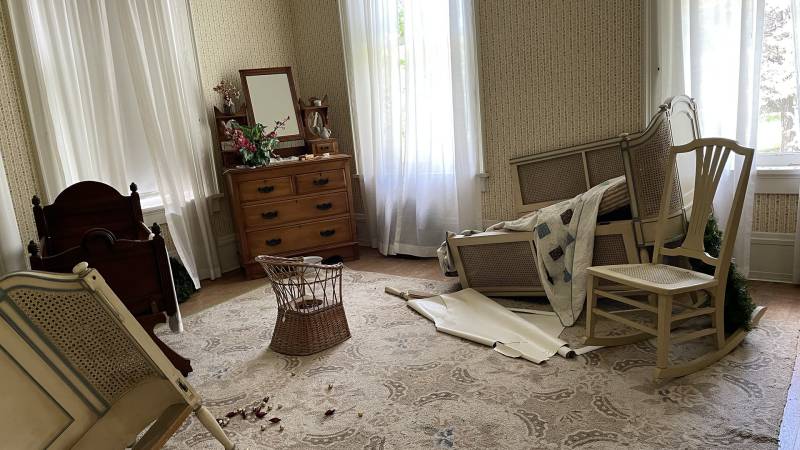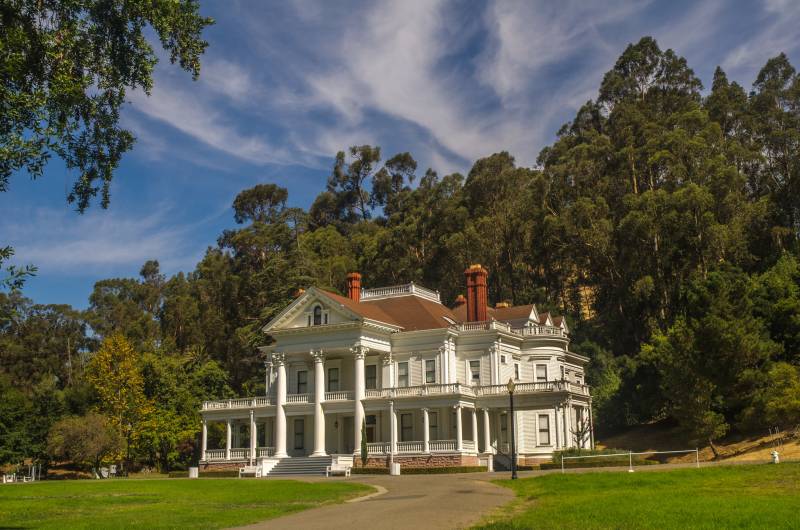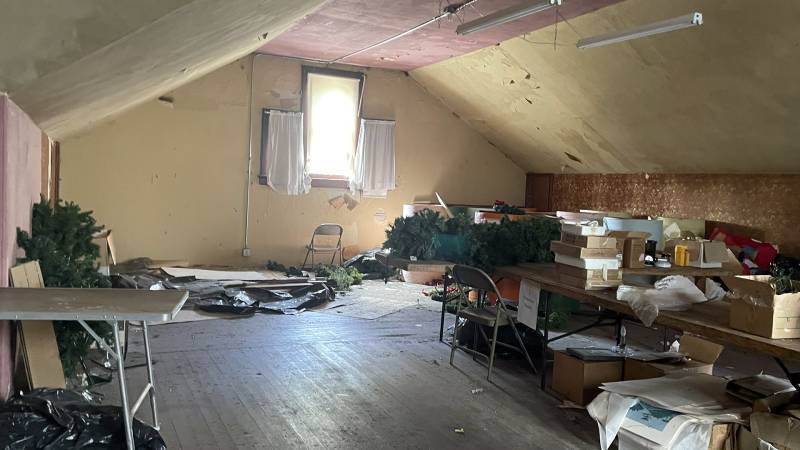Episode Transcript
This is a computer-generated transcript. While our team has reviewed it, there may be errors.
Olivia Allen-Price: I’ll never forget my first horror film. I was probably 7 or 8, spending the night at a friend’s house down the street. She pressed a tape into the VHS player – a movie her dad had rented from the 48 Hour video store that I’m pretty sure we weren’t meant to be watching. We hit play and for the next two hours, we sat … still a stone … taken in by the story of a house so haunted, nobody would make it out alive.
Music from “Burnt Offerings” fades up
Olivia Allen-Price: The film was Burnt Offerings. I didn’t sleep well for weeks.
Music fades into the Boo Curious theme song, Hip Hop Halloween
Olivia Allen-Price: It was only recently that I learned the house in the movie, the one that consumes it’s occupants, is lurking in the Oakland Hills…
Olivia Allen-Price: This is Boo Curious. Your eerie tour of the San Francisco Bay Area. Today we have a double feature for you. Part 1 takes you inside the Dunsmuir House, the dusty mansion at the center of several renowned horror films. Then we’ll head to Hayward for a centuries-old legend of love, betrayal … and gruesome murder. I’m Olivia Allen-Price. Now stay close. You don’t want to get lost.
Music ends
SPONSORSHIP MESSAGE
Olivia Allen-Price: Hiding away in the East Bay Hills is a home that has haunted the imaginations of decades of movie-goers … myself included. KQED’s Rachael Myrow went to see what hides within its crumbling walls…
Crunch of feet on gravel
Rachael Myrow: The Dunsmuir Hellman Historic Estate sits on 50 landscaped acres just south of the Oakland zoo, and as you walk up to the massive Neoclassical Revival Mansion, painted a crisp, almost blinding white, its looming immensity cuts a dramatic line against a backdrop of giant eucalyptus trees and out in front, a vast, rolling green lawn. Three giant columns in front of the front door are so big, they appear to hold up the house. Scary? That depends on whether you’ve seen the movie “Burnt Offerings.”
Movie Trailer clip: A young family, found a beautiful old house. They thought it was the answer to their dreams, but it was the beginning of a nightmare.
Rachael Myrow: This 1976 horror movie starred a host of then famous actors like Karen Black, Burgess Meredith, Oliver Reed … and Betty Davis in her final role. “Burnt Offerings” terrified generations with its tale of a possessed Victorian mansion that feeds on the life force of its guests, driving them mad, or worse.
Movie trailer clip: Bong bong bong. Oh God! Oh God! In this old house, up this staircase, behind this locked door, something lives. Something strange. Something powerful. Something evil! (:15 then fade down and under)
Footsteps, low voices moving through the house.
Rachael Myrow: Half a century later, Dunsmuir is locked up, the interior unavailable to the public … unless you get a special tour…like we did. You’d have to know what you were looking for to find the property, tucked away inside a sleepy residential neighborhood to the east of 580.
Rachael Myrow, in scene: Wow, that looks like a torture device! Not a shower.
Rachael Myrow: Unlike other Victorian mansions that have been renovated or repurposed, the insides of Dunsmuir are frozen in time.
Ominous piano music begins, mashed up with a demented version of The Sugar Plum Fairy
Rachael Myrow: The wallpaper is peeling from the ceiling upstairs and broken pieces of furniture sag onto the carpet in the nursery. The house is littered with old Christmas decorations from party preparations years ago. There are four floors from the basement on up, including everything you’d expect in a mansion, like a wine cellar and servants’ quarters.
Rachael Myrow: The couple that built this place in 1899, the Dunsmuirs, barely lived in it. Talk about bad luck: Alexander, the son of a Canadian coal baron, died ON their honeymoon. Josephine, long sick with lung cancer, died about a year later. Other families took up residence, like the Hellmans, but the 37-rooms were barely used before this estate was sold to the city of Oakland in the 1950s. In the years since, a non-profit rented it out for weddings, concerts and other events. But a giant house like this…it’s a lot to take care of.
Burnt Offerings clip of “Ben” speaking to a woman: I don’t know, with a house this size and only my wife, I don’t know that we can—
Woman: The house… takes care of itself, Mr. Roth. Believe me.
Rachael Myrow: Historian Christopher Pollock wrote Reel San Francisco Stories: An Annotated Filmography of the Bay Area. Dunsmuir appears several times in the book, because “Burnt Offerings” was just the first of several horror movies shot here, at least in part.
Christopher Pollock: We have here a piece of preservation that happened by accident, more than anything. But it helped set the stage for these movies that have been filmed here and give you kind of a creep factor.
Rachael Myrow: Dunsmuir wasn’t the first or last Victorian to play the haunted house. There’s been something about these aging mansions that haunt the recesses of our fevered imaginations … pretty much since they went out of fashion as living spaces in the late 1920s.
Christopher Pollock: Around the time of the Great Depression. People no longer wanted them. They were dark and dingy to people. They rambled all over the place.
Rachael Myrow: All those dusty nooks and crannies, creaky wood floors, musty, moth eaten carpets, and the spooky sense that people lived — and died — there before you walked in. So when a young filmmaker named Don Coscarelli saw “Burnt Offerings” in 1976, Dunsmuir struck him as the perfect place to film what would become a cult classic … “Phantasm.”
Phantasm theme song
Rachael Myrow: Dunsmuir, used in the movie as “Morningside Mortuary,” is the setting for a story about an extra-dimensional grave robber, the Tall Man.
Clip from Phantasm: Boyyyyyy!
Rachael Myrow: Fun fact: my dad co-wrote the music.
Don Coscarelli: When I met you, I must have been like 19/20, and you were about 5.
Rachael Myrow: Coscarelli grew up, as I did, in Southern California, where a certain cemetery holds a lot of the region’s dead people, and there are striking visual similarities with Dunsmuir.
Don Coscarelli: Forest Lawn which has this massive, white, NeoColonial mansion, you know, on a hill.
Rachael Myrow: After “Burnt Offerings,” Dunsmuir wouldn’t let Coscarelli film inside, for fear the shoot might cause more damage to an already crumbling house. And his movie’s massive mausoleum, ostensibly inside the massive white mansion, was shot on a set in Hollywood. But Dunsmuir’s exterior and the lawn outside effectively set the scene for Phantasm, which came out in 1979.
Don Coscarelli: We had a lot of action out there. You know, we had a 1968 Cadillac hearse that had to speed across the grass at night. At night we had a Plymouth muscle car that came racing out of the thing. And then the finale of Phantasm required this cataclysmic wind storm as the dimensions were shifting.
Clip of the windstorm from the film
Clip from Phantasm: What ever it is, if this one doesn’t scare you, you’re already dead.
Rachael Myrow: Multiple films followed featuring Dunsmuir, including “The Vineyard” (1989), “So I Married an Axe Murderer” (1993), and “True Crime” (1999). But when tourists post videos on social media from Dunsmuir, they talk about “Burnt Offerings” and “Phantasm.”
Don Coscarelli: Actually, a fan sent me a photo. They had their wedding at Dunsmuir, and I think they drove off in a hearse!
Rachael Myrow: So it comes full circle. Dunsmuir’s notoriety in the movies helps goose the local special events business, run for the last year by the city of Oakland directly. Historian Chris Pollock thinks a little TLC – well, a lot, really – could restore the mansion to the extent it might open the interior to the public, like Filoli in Woodside. Not that there are any imminent plans, but one can hope, given that the Dunsmuir House is listed in the U.S. National Register of Historic Places. And it’s pretty cool.
Christopher Pollock: I’m hoping Oakland can spend, find the funding in order to do some preservation on this house.
Rachael Myrow: Come see the outside for yourself. It’s a nice walk around the grounds…during daytime… Or treat yourself to a spooky movie tonight.
Phantasm Theme
Olivia Allen-Price: That was KQED’s Rachael Myrow.
Olivia Allen-Price: Next up, we’re staying in the East Bay, but heading about 10 miles south, to Hayward, where a story of bloody betrayal has been a part of community lore since … before Hayward was even a city. It’s called the Legend of Lone Tree … A Bay Curious listener wrote in asking about it and reporter Pauline Bartolone got intrigued…
Pauline Bartolone: This East Bay legend is something of a Romeo and Juliet story… Iterations of the tale have been appearing in newspapers and local history books for almost one hundred and fifty years…Each account has its own flair, with its own set of details…dates, names, even locations. But they all go a little something like this…
Western music begins
Voice reading 1897 newspaper clip: It was in the spring of 1830,
Voice reading archival material: “One warm summer morning, some four score years ago,
Voice reading 1874 newspaper clip: There lived in Southern California a gentleman who had a bastard son…
Voice reading 1897 newspaper clip: he was one for a father to be proud of…although compelled by adverse circumstances to a second place in caste or society.
Pauline Bartolone: And who did this illegitimate son love? An aristocratic young Spanish woman.
Voice reading 1897 newspaper clip: …Don Pedro was blessed with a daughter whose appearance caused the admiration of all who knew her,/// none could excel her in the dance or song of the country…
Pauline Bartolone: Their names? Juan and Isabel, at least in one retelling. And they were in love.
Music ends with a flourish
Voice reading 1874 newspaper clip: Without the knowledge of the parents the young people had plighted their troth and pledged unchanging love.
Pauline Bartolone: The problem was, Isabel’s father would never allow her marriage to an illegitimate man… And he promised his daughter to a Spaniard. So in the dark of night, with her arranged wedding imminent, Isabel and her lover escaped on horseback.
Voice reading 1874 newspaper clip: when inquiry was made for the bride, she could no- where be found, and it was dis- covered that the two swiftest horses were missing from the corral…
Voice reading 1897 newspaper clip: the two lovers had abandoned home, family and friends, for each other,
Voice reading 1874 newspaper clip: An elopement was of course understood..
Pauline Bartolone: As the story goes, a chase ensues… Isabel’s father tails the couple with his own band of horse-riding henchmen. And they make it all the way up to modern day Hayward…
Pauline Bartolone: In one version, they encounter an important figure in Hayward history… Guillermo Castro. He owned what is now Hayward and Castro Valley … and apparently, Senor Castro’s was the place for any weary traveler.
Caroline Sandoval: Guillermo Castro had his hacienda and he was known for being incredibly hospitable.
Pauline Bartolone: Caroline Sandoval is with the Hayward Area Historical Society recounts the most recent adaptation of the tale.
Caroline Sandoval: So this couple actually stopped to water their horses, get supplies, and to just get a little bit of rest after they got what they needed, they were sent on their way. And Mr. Castro started to notice that they were going in the direction of what was called the the old lone tree.
Pauline Bartolone: The Old Lone Tree is an Oak with winding, gnarly branches that would have stood out on an otherwise grassy hillside.
Caroline Sandoval: Because it was one of the only ones of the trees in the areas, it would have been used as a landmark for people on the property.
Pauline Bartolone: Hayward Public Library’s Hector Villasenor is a local, and first heard this tale as a child.
Hector Villasenor: So what happened was they went out to the lone tree and they didn’t come back. And then in a meantime, somebody stopped looking for the young couple. Older man.
Caroline Sandoval: an older gentleman,
Hector Villasenor: They don’t really know his name. Lost to history.
Caroline Sandoval: and he asks about the direction of the couple. Have you seen the couple? Where is the couple representing himself to be the young woman’s father.
Hector Villasenor: Saying that, he needed to look for them to give them some news. So they pointed him in the way to where the lone tree was.
Dramatic music begins
Pauline Bartolone: The father finally catches up to the young couple at the Lone Tree. This is where the newspaper writers of the late 19th century let their imaginations run amok.
Voice reading 1897 newspaper clip: the pair dismounted and placed themselves side by side, and calmly and anxiously awaited their doom.
Voice reading 1874 newspaper clip: When the parties met, not a word was spoken.
Voice reading 1897 newspaper clip: The stern Spanish Don Pascual…approached his daughter and her lover and his face gave evidence of the conflicting emotions…Scorn, pity and rage were depicted and his whole frame shook. (6:04)
Voice reading 1874 newspaper clip: The father/// drawing his stiletto, sprang to her side and buried it in her heart.
Voice reading 1897 newspaper clip: … plunged the cruel blade deeply into the bosom of his only child.
Voice reading 1874 newspaper clip: She fell and died without a word of outcry, her blood staining his hands.
Voice reading 1897 newspaper clip: Quickly the daggers of his followers were struck into the body of the lover, who expired with scarcely a shudder.
Pauline Bartolone: The bodies of the lovers were supposedly buried at the lone tree, or at least nearby, and a cemetery took root around them.
Music ends
Olivia Allen-Price: Wow. Dramatic! A Hayward twist on star-crossed love.
Pauline Bartolone: I know right?
Olivia Allen-Price: Ok do we know how much of this story really true or is it just a tall tale?
Pauline Bartolone: There are some puzzling discrepancies between the stories that make me doubt the tale. One version has the murder taking place back in the late 1700s, another in the 1830s. The later versions play up Don Guillermo Castro’s role in the whole ordeal, but he wasn’t in the area until 1839 at the earliest.
Pauline Bartolone: In one version, the lovers started their escape from Southern California, in another, a coastal town in Mexico. Either way, that’s a long way to go by horse. Lastly, one of the original trustees of Lone Tree Cemetery takes credit for writing and publishing the tale. He said the story was based on facts, but who knows what his embellishments were….
Pauline Bartolone: I will say that Caroline Sandoval with the historical society agrees that there are some discrepancies, but she thinks the stories are too detailed to be a complete fabrication.
Olivia Allen-Price: True or not – why does a story like this keep getting told time and time and time again?
Pauline Bartolone: Well like any local legend, stories like this help us learn about history. And that’s exactly what Sandoval says about Lone Tree.
Caroline Sandoval: Such a huge population of people living in this area are not even native to the state. And so there’s lots of ways that people are really kind of looking to connect to, you know, the space that they’re moving into. And the easiest way to find history is by going to a cemetery.
Ambi of area around tree and music begins
Pauline Bartolone: I of course ventured out to the Lone Tree for this story, which still stands today, next to a small creek at the Lone Tree Cemetery. A headstone nearby dates it back to the 1700s. The tree’s gnarly branches make it look wise. Whether or not young love was brutally stolen here, this tree has lived through decades of history. And its legend… will no doubt continue to ignite people’s imagination and give us all a story to share.
Music fades but continues playing softly through the end of episode
Olivia Allen-Price: Pauline Bartolone – thank you!
Pauline Bartolone: Thank you, I was happy to do it.
Olivia Allen-Price: That’s it for today’s installment in our Boo Curious series. If you’ve been digging it, please share with a friend, or leave us a five star rating or review on Apple Podcasts or wherever you listen.
Olivia Allen-Price: We’re gearing up for our next event, a walking tour of the AIDS Memorial Grove in Golden Gate Park. Featuring live dance, music and a performance from the Sisters of Perpetual Indulgence – I think it’s going to be a unique way to connect to the space, and learn about our history along the way. Tickets are limited – get yours today at KQED.org/live.
Olivia Allen-Price: Bay Curious is made in San Francisco by Amanda Font, Christopher Beale, and me, Olivia-Allen Price. We got extra help this week from Brendan Willard and Pauline Bartolone. Thanks also to Jen Chien, Katie Sprenger, Cesar Saldana, Maha Sanad, Holly Kernan and the whole KQED Family. I’m Olivia Allen-Price. Have a wonderful week!


